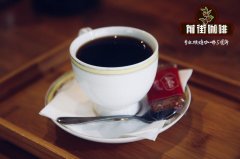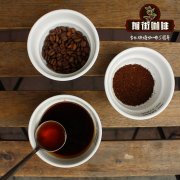The meaning of fine coffee concept and classification What grade of coffee beans are fine coffee

Professional coffee knowledge exchange more coffee bean information please follow the coffee workshop (Wechat official account cafe_style)
(this article is extracted from Zhuo Weimin's book "exploring the Secrets of Fine Coffee". It may not be reproduced or quoted without permission.)
The definition of boutique coffee
The planting of unique coffee varieties in special growing areas
The new improved varieties derived from Arabica, such as Typica, Bourbon traditional varieties and Catuai, Caturra, Kenyan Ruirull, are mainly produced at higher elevations between 600 and 1000 meters, which are different from the evaluation.
Lower Congo (Canophora/ Robusta) varieties produced at low elevations.
Good growing environment (shade planting)
Traditionally, coffee is grown under shady trees, which can avoid overexposure to the scorching sun at noon and enjoy the benefits of flocks of birds. The United States Department of Agriculture has studied that shaded planting areas can stabilize nitrogen concentration, prevent soil erosion and restrain weeds.
Growth, reducing drought and strong winds and other benefits. Compared with traditional shade planting, modern planting can grow in the hot sun without shade after variety improvement, and because there is no need for shade trees, the distance of each coffee tree can be reduced.
The output has also increased. As for the advantages of shade planting and modern exposure, there is no final conclusion, but many people in the boutique coffee industry criticize that the flavor of the new varieties of coffee is far inferior to the traditional ones, and of course some people hold different views.
A rigorous harvest
Just as the fruit of a coffee tree is at different ripening stages, selective picking (select picking) must be used. When all coffee fruits are ripe at the same time, direct picking (strip picking) can be used to ensure the quality of coffee harvest.
Scientific processing procedure
Whether wet or dry, every step must be carried out under a very scientific principle, because coffee fruit is easily fermented and spoiled at this stage. By strict definition, a rotten bean can destroy a whole batch of beans.
An intricate classification
First, use simple weight and grid classification, second, use electronic classification, and finally use conveyor belt with manual screening classification, all the classification process is to remove unsatisfactory beans. Including too small, too light, blackened, rotten, damaged, coffee core, debris, wood branches, small stones and so on.
Strict classification
The grading criteria include the altitude, density and size of coffee beans and the allowable range of defective beans.
Exquisite baking
In the concept of boutique coffee, the function of roasting is to fully show the unique personality and potential of coffee itself.
Absolutely fresh.
Under general conditions, the tasting period of excellent flavor is about three to seven days, but due to the great progress in "anti-oxidation" of packaging technology, it is generally believed that the fresh-keeping period should be extended to weeks or even months, but in the end, it should be judged by the drinker.
The single standard is "whether it has high aroma and saturated flavor".
Perfect cooking
There are thousands of utensils and ways to brew coffee. In theory, as long as you can fully grasp the following basic principles, all methods can be used to make the so-called fine coffee:
1 the correct ratio of water to coffee
2 the correct grinding suitable for brewing and cooking
3 appropriate water temperature and contact time
4 perfect stirred coffee pressed powder (coffee bed)-(espresso pressed powder)
However, in practice, the common view in the industry is that professionals must accept at least a hundred hours or more than 1000 cups.
Cooking training, in order to fully grasp the perfect knack.
The classification of fine goods
Raw bean grading system Table 2-1 sample size 300g moisture content 9% 13%
The characteristic of grade deficiency
Grade 1 Super Grade 0-5 cannot have a category of shortcomings that cannot exceed 5% in particle size / at least one characteristic in the following aspects: taste, acidity, texture and aroma / no unboiled beans after baking
Grade 2 Advanced 0 # 8 may have Class 1 or 2 disadvantages. The particle size must not exceed 5% difference / must have at least one flavor characteristic / up to 3 unboiled beans after baking.
Grade trilateral grade 9: 23 particle size 50% fits screen 15, and less than 5% meets screen 14 / no smell / up to 5 unboiled beans after baking
Level four, low level, 24086 none.
Level five, external level more than 86, none.
Raw bean grading method Table 2-2
One kind of shortcomings-- points two kinds of shortcomings-- points.
All black beans-1 is completely colorless beans local black beans-3 less than 1 stroke 2 are colorless beans
Whole sour bean-1 is completely yellow or red local sour bean-3 less than 1 pea 2 is red or yellowish brown
Dried beans / beans-1 beans completely or partially wrapped in black pericarp with shell beans-5 beans partially or completely wrapped in skin
Mildew damage-1 beans with yellow or brown mold that grow and float-5 are light in color and low in density
Serious moth-more than 53 wormholes, immature beans-5 does not grow green and contains silver skin
Other problems-1 contains other substances, such as stones, overripe and withered beans-5 light green with wrinkled skin
Shell-shaped bean-5 deformed bean with concave holes
Broken / crushed / notched beans-5 broken or notched beans
Shell / pod-5 fragments of dried pods
Nematode borer bean-10 less than 3 bores
Quaker: beans that are not cooked in baking.
Roast Uniformity: Super-not as advanced as Quaker-up to 3 unboiled beans.
Cupping Methodology: soak the cup with 150ml hot water and add 7.25 to 9g coffee powder, stir with a tablespoon, and mix in different
Important Notice :
前街咖啡 FrontStreet Coffee has moved to new addredd:
FrontStreet Coffee Address: 315,Donghua East Road,GuangZhou
Tel:020 38364473
- Prev

What exactly is the definition of boutique coffee? what elements does boutique coffee contain?
Professional coffee knowledge exchange more coffee bean information Please follow the coffee workshop (Wechat official account cafe_style) Fine Coffee (Specialty Coffee) as a proper term, it was first proposed by Ms. Erna Knustsen, who is known as the godmother of fine coffee, in the Tea and Coffee monthly (Tea Coffee Trade Journal) in 1974.
- Next

What is the Association of World authoritative organizations of Fine Coffee
Professional coffee knowledge exchange more coffee bean information please follow coffee workshop (Wechat official account cafe_style) boutique coffee introduction knowledge world-class boutique coffee association many countries have developed their own boutique coffee association, Taiwan is no exception, but for baristas around the world, there are two associations that must know, they provide a variety of courses, testing
Related
- Beginners will see the "Coffee pull flower" guide!
- What is the difference between ice blog purified milk and ordinary milk coffee?
- Why is the Philippines the largest producer of crops in Liberia?
- For coffee extraction, should the fine powder be retained?
- How does extracted espresso fill pressed powder? How much strength does it take to press the powder?
- How to make jasmine cold extract coffee? Is the jasmine + latte good?
- Will this little toy really make the coffee taste better? How does Lily Drip affect coffee extraction?
- Will the action of slapping the filter cup also affect coffee extraction?
- What's the difference between powder-to-water ratio and powder-to-liquid ratio?
- What is the Ethiopian local species? What does it have to do with Heirloom native species?

